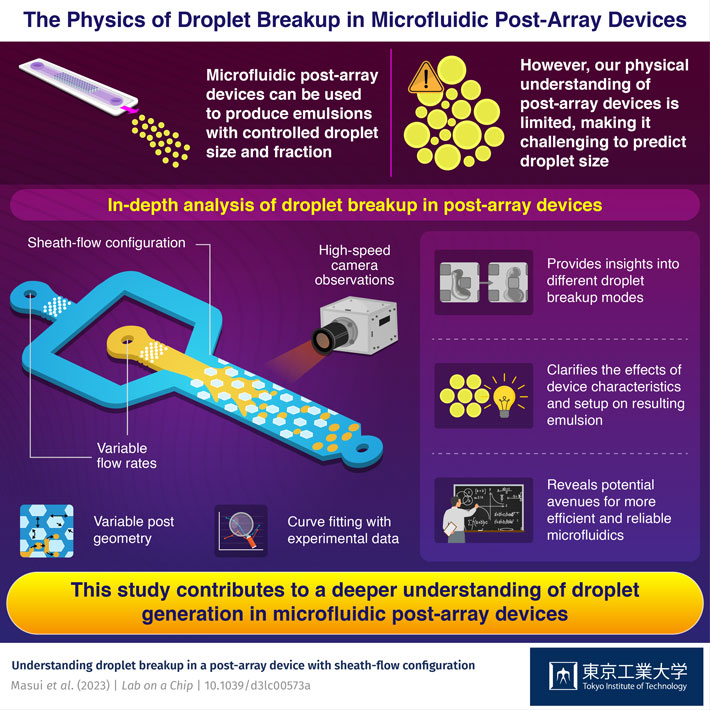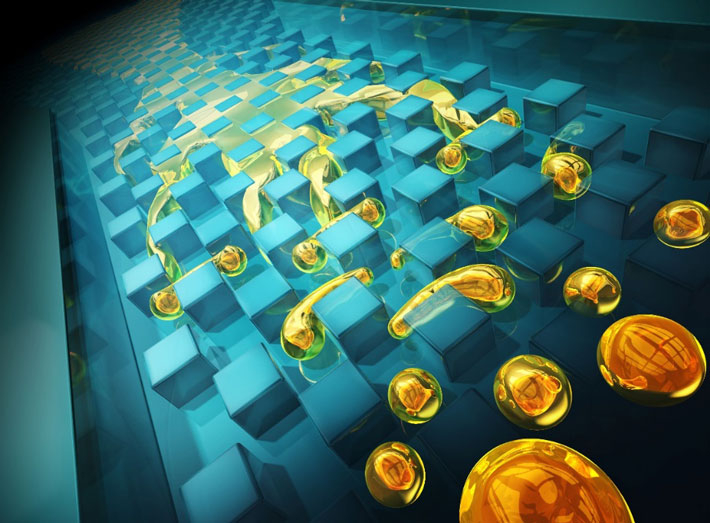The detailed physics behind droplet generation in microfluidic post-array devices has been clarified by scientists at Tokyo Tech. Through various experiments performed under different operational conditions, they gained important insights into how these small devices can be used to produce uniform emulsions, with potential applications in analytical chemistry and biology, medicine, cosmetics, and materials science.

Emulsions are mixtures of two insoluble liquids, in which one of the liquids exists as a dispersion of small droplets in the other. They are quite common in everyday life; milk, butter, facial creams, paint, and shampoo are familiar examples. Interestingly, emulsions also play an important role in laboratory applications across various fields, including analytical chemistry, biomedical research, and materials science, among others.
In most cases, these applications benefit from having emulsions in which the dispersed droplets share a similar size, also called “monodisperse emulsions.” Scientists have been on the lookout for efficient mixing methods to produce such emulsions with a high degree of control. In this regard, microfluidics has emerged as a promising approach.
Particularly, microfluidic post-array devices are an attractive way of obtaining emulsions with a desired droplet size at high throughput. These devices force minute amounts of crude emulsion through an array of regularly spaced posts. These posts break up existing droplets on impact until a finer, more monodisperse emulsion is obtained. However, although the process appears to be straightforward, the detailed physics behind microfluidic post-array devices is complex and not well understood.
In a recent study , a research team from Tokyo Institute of Technology (Tokyo Tech) in Japan set out to address this knowledge gap. The team, including Dr. Shuzo Masui and Associate Professor Takasi Nisisako, ran a series of detailed experiments to understand how various design and operational parameters in post-array devices affect the characteristics of the obtained emulsions. Notably, this study was selected for the cover picture of the journal.

The team analyzed the effects of flow rate, viscosity, and proportion of the two input liquids on droplet size and uniformity, as well as the importance of the geometry and materials of the post array. To this end, they manufactured several custom microfluidic post-array devices using a technique known as soft lithography. Using a high-speed video camera and image analysis algorithms, the researchers could precisely quantify the droplet size and observe their formation in detail.
The results highlight the significance of the effective capillary number (Caeff) in the post-array device. Put simply, Caeff is a measure related to the capillarity phenomenon that is calculated from the viscosity, velocity, and surface tension of the input liquids. “We found that variations in droplet size increased from quasi-monodisperse to polydisperse levels when Caeff exceeded a particular threshold value owing to the relative size increase in satellite or secondary droplets,” explains Dr. Masui.
Additionally, the researchers identified two distinct droplet breakup modes that could be described by equations similar to those used for microfluidic T-junctions, which are relatively simpler and well-studied as a type of droplet generation device.
Overall, the findings of this work shed light on the physics behind post-array devices. This knowledge will be essential for boosting their performance and applicability, as Dr. Masui observes: “Our study contributes to the understanding of droplet breakup in post-array devices and extends their unique droplet generation properties to include high-throughput, high-fraction, robust, and continuous emulsification processes.”
With any luck, these efforts will pave the way for efficient production of high-quality emulsions, leading not only to better cosmetics and paints but also innovations in chemical and material synthesis and scientific progress in biology and medicine via advanced microfluidics.
Reference
Authors : | Shuzo Masui1, Yusuke Kanno1, and Takasi Nisisako1,* |
Title : | Understanding droplet breakup in a post-array device with sheath-flow configuration |
Journal : | Lab on a Chip |
DOI : | |
Affiliations : | 1 Institute of Innovative Research, Tokyo Institute of Technology, Japan |








